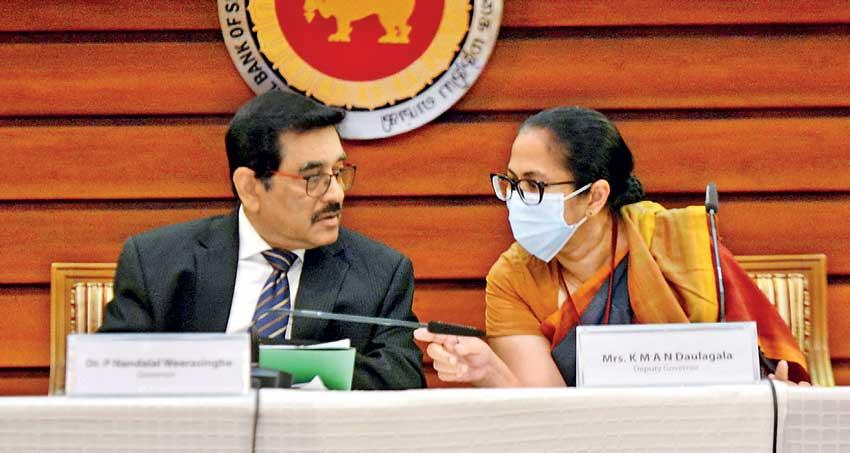26 Jan 2023 - {{hitsCtrl.values.hits}}

Central Bank Governor Dr. Nandalal Weerasinghe in discussion with Deputy Governor K.M.A.N. Dalugala during the monetary policy presser held yesterday at the Central Bank
PIC BY PRADEEEP PATHIRANA
The Central Bank yesterday left its key policy rates at their elevated levels for the fourth consecutive month, as it awaited the recently implemented measures to put further downward pressure on yields and short-term rates, while inflation expectations also remain anchored.
The monetary policy became ultra-tight in April last year, with a 700-basis-point rate hike. From July last year, the Standing Deposit Facility Rate and Standing Lending Facility Rate have been maintained at 14.5 percent and 15.5 percent, respectively.
The Central Bank believes such elevated policy rates are necessary to rein in demand-driven inflation and also to anchor inflation expectations further downward.
Speaking at the monetary policy presser yesterday, Central Bank Governor Dr. Nandalal Weerasinghe reiterated that headline inflation is projected to return to the preferred 4-6 percent levels by the end of the year.
Sri Lanka’s inflation peaked in September, when the official prices measured by the Colombo inflation index touched almost 70 percent.
However, the prices have been easing since then for three months in a row, with the December prices coming in at 57.2 percent.
The Central Bank officials are of the view that the current disinflation path would persist, supported by the subdued demand, expected improvements in domestic supply, easing global inflationary conditions and high base effects last year. The proposed power tariff hike and recent tax hikes that came into effect this month aren’t expected to reverse the trajectory in prices. Responding to a question whether the current decline in the government securities yields alongside the narrowing risk premia could improve the underlying monetary conditions, including a reversal in the current disinflation path, Central Bank Director Economic Research Dr. P.K.G. Harischandra responded in
the negative.
He said they do not believe that the yield contraction would reverse the progress made in inflation and if they notice any of such risks emerging, they would not hesitate to take swift and proactive actions. The risk premia assigned to the yields of the government securities for months, due to the uncertainty over the assurances for debt restructuring, are gradually coming off lately, with some notable progress made in that front.
The Treasury bill yields have come down by over 3 percent in the past six weeks, taking the yield below 30 percent on rising hopes of an International Monetary Fund (IMF) deal soon. While India has provided concrete assurance to both Sri Lanka and the IMF to assist the debt restructuring process, China also came on board during the weekend with their own version of support, although uncertainties abound if the letter sent to the Sri Lankan authorities can sway the IMF.
While the statement from the Monetary Board and subsequent comments by the Central Bank officials conveyed clearly that the rates are on a downward path, it is unlikely the Central Bank would resort to cutting policy rates until the IMF bailout gets unlocked.
This is because despite the recent improvements seen in the foreign exchange liquidity, foreign exchange conditions still remain a significant sour spot in the economy.
23 Nov 2024 1 hours ago
23 Nov 2024 1 hours ago
23 Nov 2024 3 hours ago
23 Nov 2024 4 hours ago
23 Nov 2024 6 hours ago